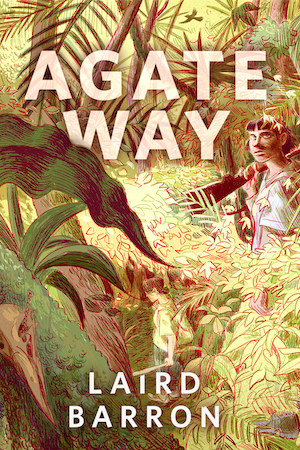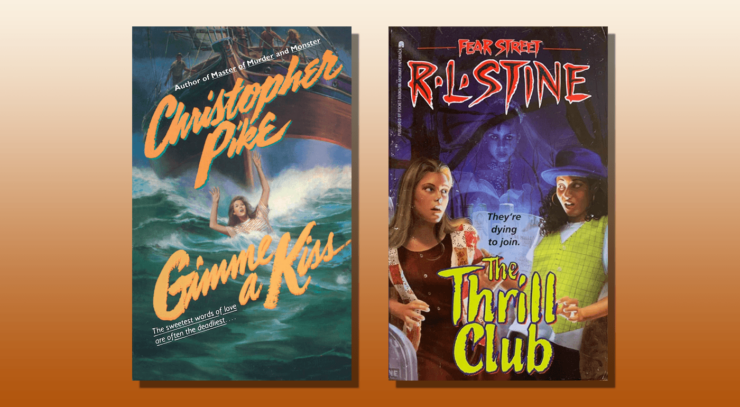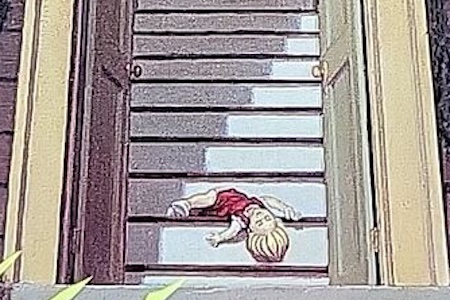Life may occasionally imitate art, but what happens when the lines between the two get blurry? In Christopher Pike’s Gimme a Kiss (1988) and R.L. Stine’s Fear Street book The Thrill Club (1994), young women write their own stories—and those of their friends—with deadly consequences. In Gimme a Kiss, Jane Retton keeps a diary, but instead of chronicling what actually happens in her day-to-day life, Jane writes a sexy fantasy version, playing out the passions she longs to fulfill but remains too inhibited to pursue, a disconnect that complicates matters when some of her classmates read her diary and believe it all to be true. While Jane’s “diary” is fiction masquerading as fact, in The Thrill Club, Talia Blanton’s horror stories feature her friends in starring roles, but when they die in her stories, they begin dying in real life, as her terrifying fictions become all too real. In both cases, what these young women write has significant power, shaping the world around them and spelling death for some of those closest to them. And while there’s some power in writing their own stories, the threats Jane and Talia must contend with come from some unexpected directions.
Christopher Pike’s Gimme a Kiss features a pretty complicated love triangle: Jane is dating Kirk Donner, who used to date her friend Alice Palmer, and while Alice says she’s fine with Jane and Kirk’s relationship, it sounds like Kirk asked Jane out before he had actually broken up with Alice, though that didn’t slow Jane down in saying yes. Jane and Alice’s friend Sharon Less is the only one to mention to Jane that this was a pretty awful thing to do, but Jane shrugs off the criticism and Kirk never seems to give any of it (or the girls themselves) much of a second thought, including when he later starts flirting with Patty Brane, a cheerleader with a salacious reputation, while he’s dating Jane.
The reality and the fantasy of Jane and Kirk’s relationship don’t match up. Jane doesn’t really seem to even know Kirk all that well. Apparently his major selling point is that Jane “had never had a boyfriend before. She was determined to hold on to him” (20). She gets the sense that she and Kirk are drifting apart and he doesn’t seem all that interested in spending time with her. But the “real” Kirk is nothing compared to the Kirk of her fantasies. As Jane writes in her diary entry for October 6th, “Dear Diary … I’ve been very naughty. I’ve gone and done what no good girl should do. I’ve lost my virginity. And I know exactly where I lost it. But let me tell you, there’s no getting it back” (17). But the truth is that Jane and Kirk never had sex: it’s all just a story she wrote to amuse herself and satisfy (at least to some degree) her sexual curiosity. Despite Jane’s emphasis on the importance of her virginity in the diary entry, she doesn’t seem to see much distinction between having sex and pretending she had sex, musing “he had kissed her, long and deep. The event had taken place in space and time. What did it matter if he hadn’t really spent the night?” (20). And her diary is for her private thoughts, for no one’s eyes but her own, so what she writes there and the veracity of those accounts really shouldn’t matter beyond Jane’s own perceptions.
But of course, that’s not where the diary stays. Alice and Sharon read Jane’s diary, the notebook ends up in Jane’s backpack, and when she leaves it unattended in her homeroom class, Patty finds it, photocopies some of the most lurid pages, and shares them with the whole school, whose perceptions and treatment of Jane immediately take on a more sordid turn. When Jane tries to tell people she made it up, they think she’s just trying to salvage her reputation, an assumption which is reinforced by Kirk happily telling all of their classmates that everything Jane wrote is true. It bolsters Kirk’s own sexual reputation, though he tells Jane that’s the furthest thing from his mind: he just didn’t want people to think Jane was a liar, so really in his own roundabout way, he was standing up for her and trying to do what he thought she wanted him to do.
The harassment and ostracization of her peers is bad enough, but where things get really disturbing are in Jane’s interactions with adults who have heard about or read her “diary” entries. First, Jane is called into the office of the high school guidance counselor, Mr. Pan, who first congratulates Jane for what he perceives as her uninhibited attitude about sex, then foists a bunch of free condoms on her, telling her “Please, for my peace of mind, take them and take care of yourself” (56). Alice tries to serve as a buffer between Jane and Mr. Pan, questioning the legitimacy and appropriateness of this interaction (which comes across as an adult man having a creepy interest in a teen girl’s sex life), while Sharon is happy to grab all the free condoms she can get her hands on, and mortified Jane is caught in the middle, still reeling from the “leaked” diary pages and trying to head off the incredibly uncomfortable conversation Mr. Pan seems intent on having.
Jane also works part time for Alice’s father in his dentist office, and when she shows up for work that afternoon, Dr. Palmer pulls her into a private room and tells Jane that she needs to be strong, which “means to respect your body, to put that respect above carnal desire. Do you understand what I’m trying to tell you?” (66). When Jane attempts to tell him that she really didn’t do anything, he never considers that she may be telling the truth and is instead horrified that she sees sex as “nothing.” He ends their conversation by extracting a promise from her, saying “you’ll be good? You must promise me you will” (66). As long as Jane is a “good” girl, all will be well, but if she strays from that prescriptive moral path, he won’t let Alice be her friend anymore and he’ll fire her from her afterschool job. In each of these conversations, adult men attempt to isolate and corner a teenage girl to talk about her sex life, and while their motivations may be very different, they’re both really unsettling.
Once Jane has had a chance to regroup, she decides her best option is to enact out a complicated revenge scheme, which (inevitably) goes awry: she gets into a public argument with Kirk and Patty on the deck of a boat, then “falls” overboard, planning to fake her own death—framing Kirk and Patty for her murder. She has scuba gear waiting underwater, so she can make a getaway, leaving everyone to assume she has drowned and been lost at sea, which isn’t much of a consolation to Kirk, who drowns while trying to rescue her. Sharon is in on the plot and offers her family’s nearby cabin as a place for Jane to lay low, though this goes horribly wrong when someone shows up to attack Jane, first shooting into the cabin and then setting it on fire. When Sharon comes to check on Jane, Jane whacks her in the head with a fireplace poker, accidentally killing her. Jane has worked hard to construct her own narrative, both in her diary entries and in her revenge scheme, and in both cases, the truth is even stranger than fiction, taking Jane’s life in unexpected directions, with horrifying consequences.
Contrary to Jane, Alice has a reputation as a repressed “good girl,” determined to please her overbearing father. But it turns out that Alice is keeping some deep (and poorly informed) secrets: her relationship with Kirk was more physical than she let on and she contracted the herpes virus from him. Alice is horrified and hysterical, telling Jane that Kirk ruined her life and “No one will ever kiss me again” (148). Alice fundamentally misunderstands the virus and transmission in general, adamant when she tells Jane that “Only bad boys can give it to you” (148) and that Kirk gave it to her in an attempt to get rid of it himself, by passing it on to her. This confrontation is the final twist in a convoluted revenge scheme, with Alice attempting to either shame Jane into good behavior or to kill her to save her the shame of being labeled a “bad” girl.
In Stine’s The Thrill Club, Talia’s stories are fictional creations, tales that she writes to share with her horror aficionado friends of the Thrill Club. But even this claim is more complicated than it first seems: these are fictional stories, but the members of the Thrill Club appear as characters within them to be menaced and murdered. The blurry lines between fact and fiction are echoed by the structure of the book itself, where Talia’s stories are presented in exactly the same format as the other chapters, rather than appearing in italics or some other distinguishing format, which means that the reader has to discern between what’s real–and what is one of the stories being shared with the club. This act of fictional creation is complicated even further when it turns out that Talia hasn’t written the stories at all: her boyfriend, Seth Varner, wrote them, then let Talia take the credit. Finally, things get even messier when the people featured in Talia’s stories start actually dying, in exactly the ways she described in those stories: in the story that opens The Thrill Club, for example, Shandel is walking home alone at night by the cemetery when her throat is cut, which is exactly where and how she is found just a few days later. When Talia and the others realize the parallel between her story and Shandel’s murder, “Talia leapt back from Shandel’s body, as if someone had shoved her. A wave of nausea swept up from her stomach. She opened her mouth to scream, but no sound came out” (54). There’s no logical reason for Shandel’s death to mimic Talia’s story, but the truth of it is undeniable.
Much like Gimme a Kiss, romantic intrigue and tension is central to The Thrill Club: Seth used to be Maura Drake’s boyfriend, but now she’s dating fellow Thrill Club-er Rudy Phillips. Maura still has feelings for Seth, though whether she cares about him as a friend or is actively trying to win him back remains undetermined, and there’s no shortage of other girls interested in Seth too. Talia feels a distance between herself and Seth, though she’s not quite sure whether it’s because now that she has him, she’s lost interest in him, or because he’s just not himself since his father’s unexpected death a couple of weeks ago. The way Talia figures it, if Seth would just stop being so sad and pay more attention to her, everything would be fine. When Talia’s feeling neglected by Seth and kisses Rudy, she has to wonder whether Maura’s the one out to get her, now that Talia has put the moves on not just one, but two of Maura’s boyfriends.
Much like Jane in Gimme a Kiss, self awareness isn’t really Talia’s strong suit. But while Jane never actually loses sight of who she is and what she’s doing (even when what she’s doing is ridiculous), Talia loses hold of her own identity. Talia has large chunks of time where she can’t remember where she was or what she did, then comes back to herself to find bloodstains on her sweatshirt. When Shandel Carter is the first teen murdered following the pattern of one of Talia’s stories, Shandel’s mother tells the police that Talia called her on the phone and confessed to killing Shandel, a call Talia has no memory of making. Later, Talia is mad when she sees her friend Nessa flirting with Seth at school, but Nessa and Maureen tell Talia that she called Nessa on the phone the night before and told her she was going to break up with Seth, giving Nessa her blessing to ask Seth out. And while Talia can’t imagine herself killing anyone, she can’t actually say for sure that she didn’t do it … because it turns out she did.
Jane’s plot in Gimme a Kiss was convoluted, but the machinations of The Thrill Club are next-level ridiculous: Seth’s father was an anthropologist who was studying “a primitive tribe in New Guinea” (24) prior to his death. The Thrill Club positions these problematically unrepresented people as a kind of far-reaching bogeyman, whose influence can be passed on through audio recordings, which were responsible for killing Seth’s father. One night after a Thrill Club meeting, Seth plays one of these tapes for Talia, who is unsettled by the “chanting voices. Deep voices and shrill ones, chanting together in a steady, machinelike rhythm … The strange voices grew louder. The rhythm picked up, faster, faster” (24-25). Seth falls into a kind of trance, chanting along with the recording, while Talia grows increasingly frantic, begging him to turn it off. He does, but the hypnotic suggestion has already taken hold, and this is how Seth controls Talia, influencing her and using her to kill their friends, make phone calls she doesn’t remember, and confess to murder. There’s no real rhyme or reason to why or how this recording works; it’s almost like a weapon that anyone can pick up and wield indiscriminately. Seth has seen the damage this recording caused his father and the fallout for himself and his family, but has no reservations about co-opting it and using it to his own ends. When Seth’s nefarious plan is discovered, he uses the same chanting to “escape” (147), taking his own life and removing himself from any possibility of being held accountable for his actions.
Both Jane and Talia enjoy telling stories, whether they tell them to themselves or to their friends, and the lines between fact and fiction can be hard to determine. In some respects, the idea that these girls can chart their own courses and determine themselves through the stories they tell is refreshing, but their tales, and their tellings, are complicated. Their stories may or may not be true (as in Jane’s case) or the girls themselves may or may not be the authors of those stories (like Talia’s), but the perceptions of other people overwrite these young women’s words. In Gimme a Kiss, after people read Jane’s “diary” pages, they make up their minds about just what kind of girl she is and nothing she says or does can change their minds. In The Thrill Club, Talia is doubly-damned by both the stories she claims as her own (when they aren’t) and the truth she actually tries to tell (only to have no one believe her). Jane and Talia may be able to spin a good yarn, but they’re the ones who get tangled within it when everything goes wrong.














